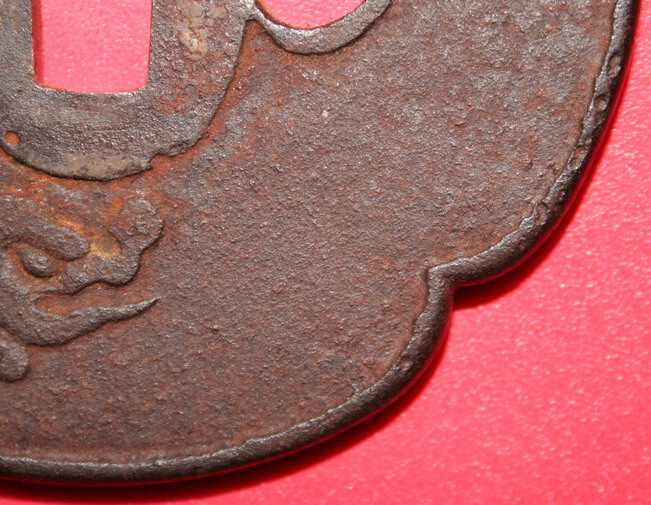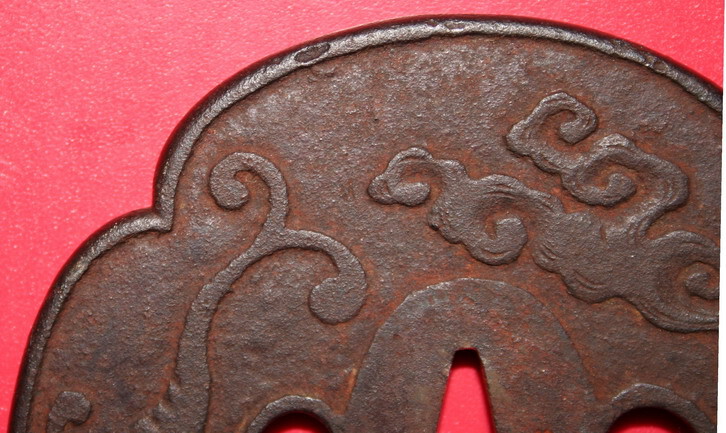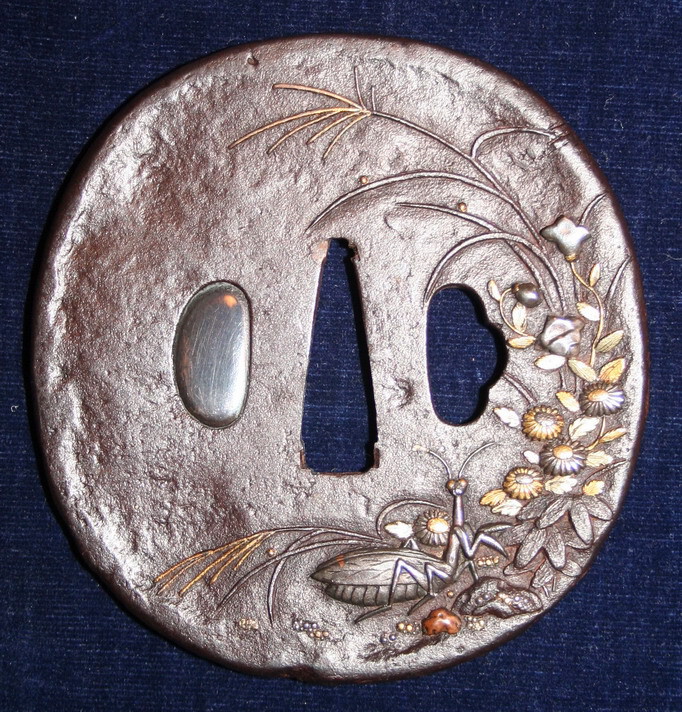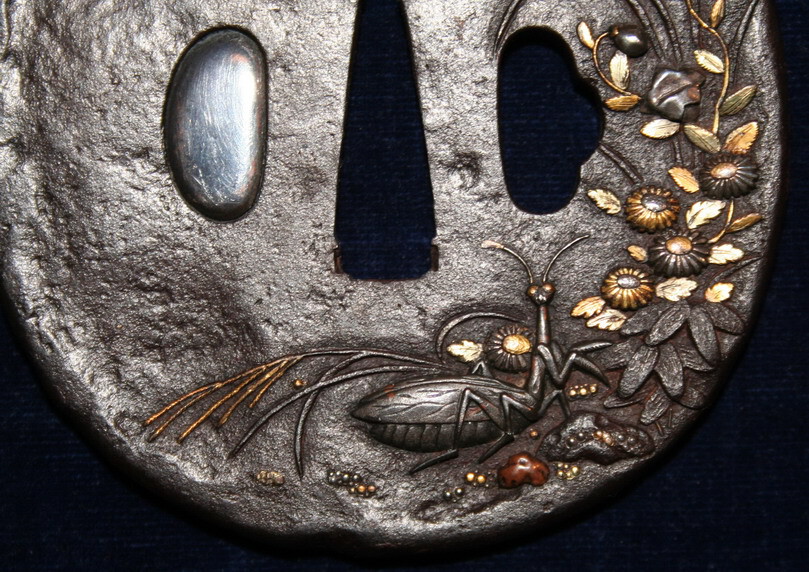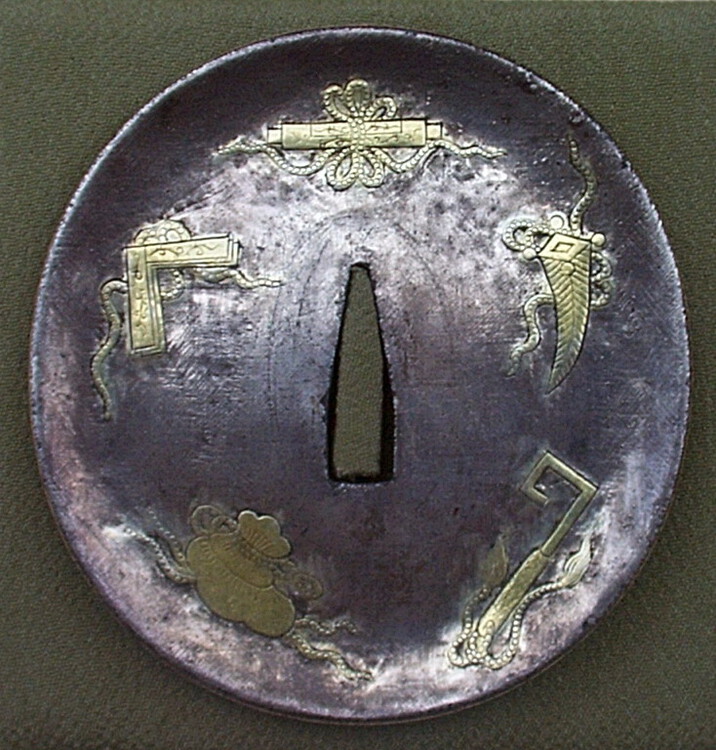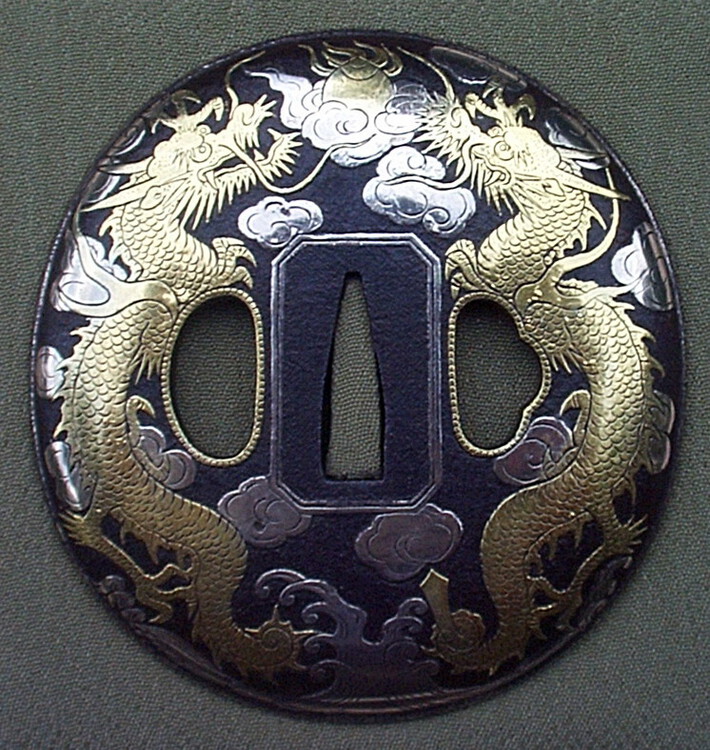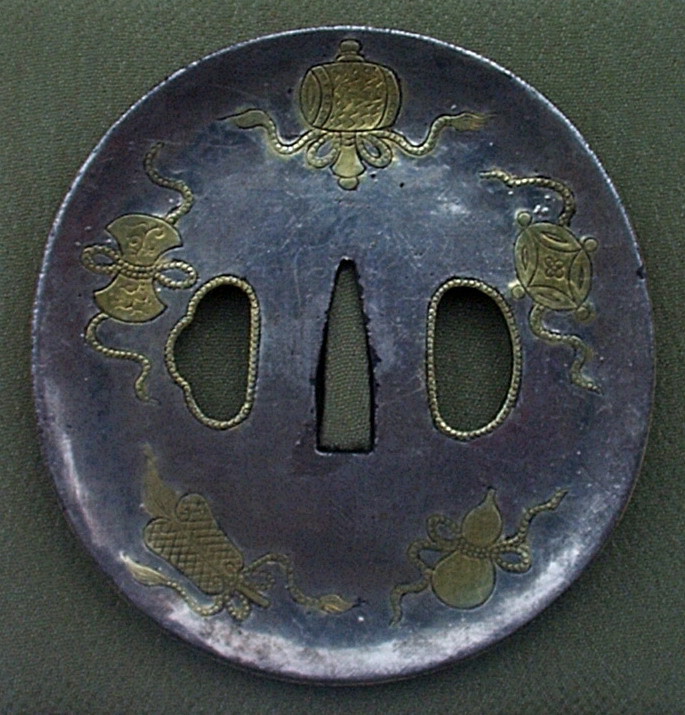-
Posts
2,744 -
Joined
-
Last visited
-
Days Won
27
Content Type
Profiles
Forums
Events
Store
Downloads
Gallery
Everything posted by Bazza
-
Guido, I was surprised to see your question - mainly because I thought you knew "everything"... Even more surprised that I might be able to contribute to this thread!! For years I have known the theme as "Buddhist Wheels in Water" so I popped these keywords into google (no quotes) [ buddhist wheels water ] and got a stack of hits - lotsa reading there me hearties. Then I searched within those results with [ Japan ] with about 400,000 hits. I would hope there is a simpler answer to Guido's question, but I wonder if this would suffice as a start: ----------------------------------------- The wheel is an emblem of Buddhism, a religion introduced to Japan from China in the 6th century. Chinese classics like the Lao Tzu mention that the revolving wheel was considered a direct symbol of the universe. Originating in India, the rinbō or hōrin (Sanskrit: dharmachakra), the Wheel of Buddhist Law, is adopted from the Middle Eastern chariot wheel and represents the completeness of Buddhist doctrine, while its eight spokes signify Buddhism's "eightfold path" to enlightenment. A rinbō appears in the exhibition on a kind of altar from a temple in Japan that similarly depicts crossed vajras, Buddhist emblems that are considered to represent the Wheel of Buddhist Law as well. ------------------------------------------ ( http://www.morikami.org/index.php?src=g ... y=Exhibits ) Of course, water is not mentioned here, but the above would seem a fruitful line of enquiry for more fruitful discoveries - perhaps someone already knows "The Answer", in this case most certainly not 42... Regards, Barry Thomas.
-
I agree. The first thing I noticed was the extreme "chippy" style of the kanji (meibun???) and I immediately said to myself "GUNTO". Until Grey raised the ugly word I was simply going to ask if this "chippy" style was around in Koto times. I don't believe so. I too have seen other swords with a "rust spot" right where an arsenal stamp would be... Regards, Barry Thomas.
-
MATE, I DON'T THINK I'LL SEND YOU THAT BOTTLE OF WINE AFTER ALL... Regards, Barry Thomas.
-
Grey, Yes, the sword has to be seen in hand. I honestly cannot comprehend how a "perfectly hardened kissaki" can bend at the tip without breaking. I understand you've seen it with your own eyes Grey, but I wonder about the "hardness" of the yakiba and battle-worthiness in such a case. However, always something to learn and I've tucked this nugget of yours away in my memory banks for a future encounter. I have myself seen only one blade that had the tip bent AND BROKEN - it was hanging on by the kawagane and would probably have broken completely off if straightened. Frankly, I would be very suss about any sword with a bent tip and a hamon. Of course, it would depend on everything else. On Koto being crack resistant, a Japanese collector visiting one day commented that Koto were good because if it bent on the battlefield you just straightened it over your thigh and continued on, and demonstrated pantomime-style as he described this process. Best regards, Barry Thomas.
-
Yes - here is my reply to this question from thread viewtopic.php?f=50&t=5959&st=0&sk=t&sd=a&start=30: Bruno, My opinion is that it is fatal because it should have broken in the first place if it was correctly hardened. The bend as opposed to a break means the steel is soft, which means it isn't correctly hardened or has been damaged by excessive heat that has drawn the hardening. Either way definitely a sword to be avoided like the plague IMHO (In My Humble Opinion) Regards, Barry Thomas.
-
Bruno, My opinion is that it is fatal because it should have broken in the first place if it was correctly hardened. The bend as opposed to a break means the steel is soft, which means it isn't correctly hardened or has been damaged by excessive heat that has drawn the hardening. Either way definitely a sword to be avoided like the plague IMHO (In My Humble Opinion) Regards, Barry Thomas.
-
Curran, Yes, coming later. I'll have to take them. The koshirae has some very interesting features, one of which a visiting Japanese togishi said he had never seen before. As a teaser, the same is lacquered gold and the remaining menuki is a swastika. This appears to be very much a custom-ordered sword from the blade to the koshirae. Thanks too for your opinion Rich. As a result of this little exercise I have looked even more closely at this tsuba and have discovered a couple more things about it. I'll try and photograph them with my macro lens, but it could take a few days before I'm back. Regards, Barry Thomas
-
Well, it is with some trepidation that I venture here with an iron tsuba that may be in the category of (quote Guido) "the junk, fakes and mediocrity that is posted here so often"!!! I've had this for nearly thirty years and have always been somewhat indifferent to it alongside its Goto and Ishiguro shakudo nanako cupboard-fellows. It is, however, original to a handachi with original koshirae and katana dated 1862 by SENDAI HYAKURYUSHI NAGASHIGE (Hawley Brown Book NAG 106?). It fits the characteristics noted - granulated appearance, sukidashi bori, thin?, naive and not signed. The two pictures below show the front and back of the tsuba, dimensions 83mm high x 76mm wide x 3.5mm thick at seppa dai and 4.0mm across mimi. The last two pictures are of some marks on the mimi that could be corrosion pits, but I'm of the opinion that they are deliberately placed. An imitation of Nature's worm holes??? The tsuba has a muted ring when struck (not sonorous, like a bell) and shows evidence of forging with a fold line evident on both sides of the nakago ana and a small fold evident on the mimi. I don't for a moment think this is a first period Kamakura Bori tsuba. I've always thought it was Edo period and was obviously chosen carefully by the owner of the (made to order) Nagashige katana, which by the way is a long, slim blade quite unlike any I've seen before. I've wondered if it was a Fukkoto interpretation of a Heian tachi!!! Anyway, I'd appreciate any opinions on this tsuba that appears to conform to the characteristics of a Kamakura Bori tsuba. Best regards, Barry Thomas.
-
OOOOOPS - I'm sorry, but in general the designations of these swords go right over my head, my gaze being focussed a little further back in time... I hope somebody gave you a good answer for your REAL question instead of my rambling... Best regards, Barry T.
-
G'day All, This is a continuation of a discussion at viewtopic.php?f=50&t=5959 The discussion was about ishime lacquer on gunto scabbards. I thought of a sword I catalogued for an auction here in Oz about 18 months ago. I'd love to have bought it but was financially committed elswhere, so it was bought by someone else. I hope they treasure it because I loved it. The sword is the most unusual Shingunto koshirae I have seen and recorded it for posterity. Anyway, here is my catalog description with the photos following. I hope it is all self-explanatory. Oh, the mei is INSHU JU KANEYUKI. There is no such recorded smith in Hawley or in 18 other books a friend of mine searched, and NO oshigata of any Inshu smith. However, Hawley records smiths in INSHU (Inaba Kuni) from the Kamakura period right to Meiji. I have a spreadsheet of all the smiths in Hawley (I'll try and upload it). It would appear that the Inaba smiths are "backwater" artisans, although a Kamakura period smith is indicated as Juyo. Best regards, Barry Thomas. ------------------------------------ KATANA: Shinogi tsukuri, (ridge line & yokote); 69.9cm blade, tang 21.5cm, curvature 2.0cm, thickness 0.70cm; in original Japanese polish (some rust pitting & cleaning at point); itame hada (irregular grain pattern); notare hamon (“long wave” undulating temper pattern) with peaks resembling Mount Fuji; tang in g. orig cond, nice patina & filemarks, incised in nicely cut characters IN SHU JU KANEYUKI. A sound Shinshinto blade ca 1820. Koshirae: WW2 Japanese Army shingunto, the whole complete & g. cond; exc orig, clean brown silk binding to handle; family crest on kabutogane (end handle fitting); g. rayskin (slight cracking); brown silk rank tassel present but badly frayed & worn attached to scabbard hanger (remnant of original silk hanger still in kabutogane). This sword has 3 very unusual features (i) scabbard is finished in true urushi (lacquer) in russet-brown (slight scuffing & cracking); (ii) scabbard mouth has an additional protective collar to keep out dust & moisture; (iii) on each side of the handle between rayskin & wood core is a thin strip of silver or nickel-plated iron. Clearly this unique sword was of special significance to its wartime owner. $2500 - 3000 ------------------------------------
-
OK All, The image I particularly wanted to show for Bruno as to quality urushi (traditional lacquer) finish on shingunto swords is this one: The rest of the sword is off-topic and I'll post those on the Board index » Nihonto Discussion list under a new thread UNUSUAL SHINGUNTO. George, I also have a damaged Shingunto lacquered saya that is damaged and shows the cloth underneath the lacquer. Bruno, all this is to say that your "green" scabbards look to be traditional lacquer and should be preserved as such. Best regards, Barry Thomas.
-
Dear Old George - make sure you have company if you venture out into the dark!!! Your comments encourage me to put here for your attention an extremely interesting Shingunto with ishime urushi saya that I catalogued for an auction here some 18 months ago. I would love to have bought it, but I had already savagely abused my credit card on sundry other Edo-malia!! However, the night is late and I'm knackered (Aussie expression for "tired beyond belief"), so I'll attend to it tomorrow - watch this space. Best regards, Barry Thomas.
-
G'day All, Ahhh, the first mention of "ishime". Firstly, most of the blades (sample of about 6 swords) I have seen in these mounts have been better class gendaito, and if not "good" then named smiths "in the books" and not poorer factory productions. Secondly, this seems a good time and place to ask my question about the green scabbards of "ishime". I have also seen this finish on the more normal Shingunto as well. It appears to me to be genuine urushi, that is to say, real ishime lacquer, the same as on katana of old. In which case, Bruno, I opine that this is a very expensive finish in its day and very traditional. To even think of taking it off amounts to a heinous crime IMHO. I have seen nothing in print about these ishime scabbards and would love to hear the opinions of others. Best regards, Barry Thomas.
-
Could I be bold enough to say this has a "modern" look?? Perhaps early 20th century??? No analysis here, no books, just a certain "look" about it compared to my "memory bank average" of many years... On the colour difference observed. Discussion here has talked about the complexities of colour calibration in monitors and digital photography. I can only think of white balance vis-a-vis light source???? Best regards, Barry Thomas (Melbourne, Australia)
-
Dear Brethren, This is a lovely koshirae Ford. Meiji period??? I did a google search using keywords [ baleen buying ] and turned up this very interesting thread: http://www.city-data.com/forum/alaska/3 ... aleen.html So I guess baleen is available if one looks hard enough. I think I might have some pics somewhere of another koshirae - if I find it I'll put it up. Regards, Barry Thomas
-

Translation assistance on Chinese Auction (?)
Bazza replied to SwordGuyJoe's topic in Translation Assistance
Koichi san's image of So Tsutomu compared to the "China" auction sword nakago shows how difficult it is to do yasurime artfully. Regards, Barry Thomas. -

help needed with a mei that endds in mitsu
Bazza replied to b.hennick's topic in Translation Assistance
Barry H, Off the top of my head - UJI MITSU??? Barry Thomas. -
G'day All, I would be equally interested in a list of Mukansa polishers. Always the polisher is the shadow behind the smith, or so it appears to me in this Nihonto backwater. I imagine that in Japan the polishers are as well known as the smiths??? Regards, Barry Thomas.
-
G'day All, I particularly enjoyed Ford's discourse on the aesthetics of the Kanji and Markus' additional information. I thought of the beautiful inscriptions we find on Meiji metalwork where the chisel work takes one's breath away. Of course, one can follow lines of discussion to the nth degree, but I did find a further comment on Reisho script that i thought was useful: http://www.stockkanji.com/info/Glossary.htm "Reisho (Clerical Script) is a simplified version of the tensho script that is dominated by horizontal and vertical lines. This is sometimes called the "Clerical Script" and in the Han Dynasty (206BC - 220AD) served to simplify the tensho script and therefore make it more appropriate for practical purposes. The overall shape is rectangular with a height to width ration of two to three. Today this simplified version of the tensho style is used only for newspaper names and in stone carving (e.g. grave markers)." Regards, Barry Thomas.
-
Ken, I recently found a tsuba with your favourite theme. A friend has a Kanesada katana with a mantis theme iron tsuba. Not strictly Heianjo, but as this thread seems to have worn itself out thought I'd just put it here for your benefit Old Mate. Now, I'm not a tsuba man so would appreciate comments anyone cares to make. IMHO this is a very good tsuba, noting the finely worked coloured metal inlays in the body and neck of the mantis as well as the "red rock" in the foreground. The sculpted surface of the tsuba with a barely discernible mimi has a good aesthetic feel. I apologise for the "hard" looking surface due to the flash lighting, but I had only a brief opportunity to take the pic. Best regards, Barry Thomas.
-

samurai sword 1450-1550 a.d.
Bazza replied to snatch13's topic in General Nihonto Related Discussion
After all that has been said, mostly to good advantage for the persistent reader, I come back to my first feeling on viewing the fuzzy photo of the putative shumei. I thought (as someone else commented) that the lacquer looked "fresh" (synonym "new") and very much the wrong colour, as if a 'modern' aniline dye/pigment was used in the urushi instead of the cinnabar of old (red mercury sulfide (HgS), or native vermillion). The sword itself could of course be polished and put to Shinsa without removing the shumei, then removing it if and only if the Shinsa result was divergent. I learnt some fine points in this protracted thread, as I hope some of the participants did!! Regards, Barry Thomas. -
I'm staggered by the similarity to my Namban tsuba already presented. The 'proof of the pudding' would be in the shape of the nakago ana and there is no doubt that my tsuba is Japanese in that regard. I would speculate that the Tibetan sword (a friend once owned a very good one) would have a rectangular tang - is there then any connection between a Tibetan rectangular tang and the rectangular seppa dai on a Namban tsuba?? I imagine Tibetan 'Namban' tsuba would be very rare in Japan, so perhaps they inspired copies more in the Japanese style for katana??? Regards, Barry Thomas.
-
To add a little more to this very interesting thread, but first, on Sun Jun 14, 2009 9:54 am Piers wrote: > Some time ago, Barry asked me to post hi-res pics of this Namban tsuba, > (the only one I have, likewise) and I did, but never found out why. Piers, sorry about that. I just simply lost track of it in a busy life, but I certainly recall asking the question. It was simply to add a higher resolution image to my files on Namban tsuba. Earlier, on Sun Jun 14, 2009 7:10 am Dr John L wrote in response to my statement that I thought the NBTHK had attributed my tsuba to 17th century: > But C17? The concavo-convex profile that Barry describes indicates to me > a European influence and a possibly rather later date of manufacture. It only then struck me that with all the gold and quality could Genroku be a reasonable period to attribute its creation??? To add to the concavo-convex profile I submit images of a daisho tsuba. Probably not Namban, but almost certainly Hizen??? The images clearly show that the tsuba have been mounted on koshirae at some time, as 'normal shaped' seppa wear patterns are evident. How the front of the tsuba with the rectangular Namban-style seppa dai were fitted begs the question and harks to Reinhard's question about such tsuba being made by "...people who did not know Nihonto". I would suggest these tsuba are of the highest quality workmanship, which still leaves us with Reinhard's question... Regards, Barry Thomas.
-
Reading this thread I realise how little I know about Namban tsuba - but then, I'm a "blade man'!! For "SHOW AND TELL" I've put two images of my one and only Namban tsuba below. It is 83mm high x 75mm wide x 6.5mm thick. In the first NBTHK Shinsa in the USA it was given a Tokubetsu Kicho paper and noted (if my memory of 40-ish years ago serves me correctly) as 17th century. A polisher from Japan looked at it a few years ago and said "A real one!" He knew what "Namban" meant to him, but in the line of a comment above, does it relate to what Namban meant in the early Edo period?? This tsuba is particularly interesting I feel because the front is convex. The seppa dai and the dragons and scroll work are in a flat plane, but the rim containing the two dragons and scroll work is about 1mm below the flat plane, and the inside bound of the outer border beading is about 2mm below the flat. The gilt plate on the front seppai dai is loose and when removed reveals an abstract cloud pattern sunk below the flat plane by the thickness of the gilt plate, suggesting this was an original design feature? Given the erudite comments here about "the artist's intention" I am bereft of any comments and look forward to the collective opinion on this tsuba. On Chriso's question "is anyone aware of any other publications on Nanban????" I have not seen any discussion on the merits of Boxer's article in the Transactions of the Japan Society, London. The only comment I recall without reading it all again is that a beaded rim indicates an earlier piece. Anyone?? Regards, Barry Thomas.




